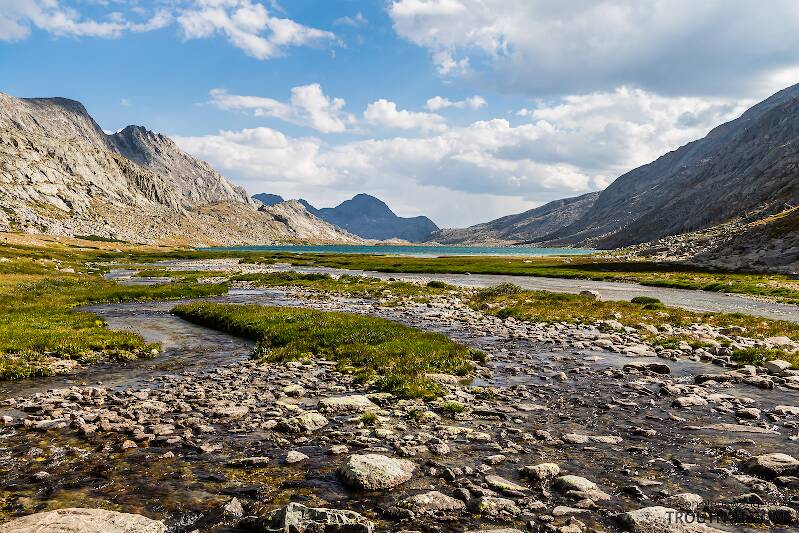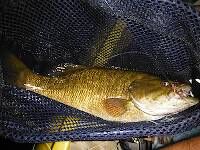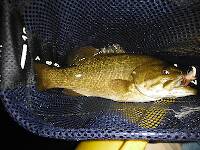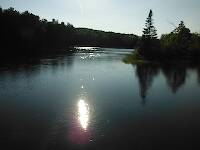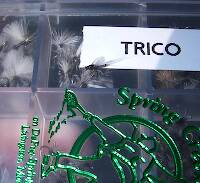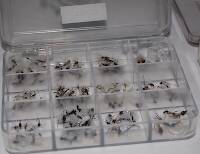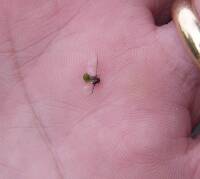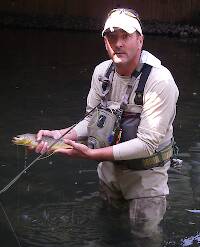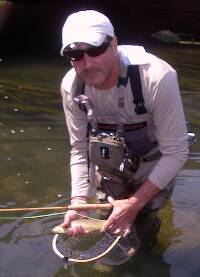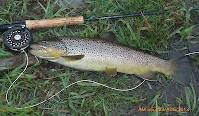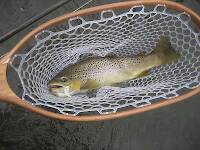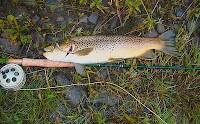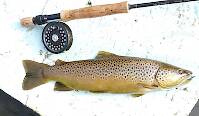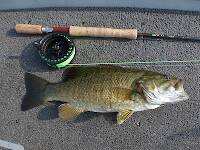
Salmonflies
Pteronarcys californica
The giant Salmonflies of the Western mountains are legendary for their proclivity to elicit consistent dry-fly action and ferocious strikes.
Featured on the forum

This is the first of it's family I've seen, collected from a tiny, fishless stream in the Cascades. The three species of this genus all live in the Northwest and are predators that primarily eat stonefly nymphs Merritt R.W., Cummins, K.W., and Berg, M.B. (2019).

Troutnut is a project started in 2003 by salmonid ecologist Jason "Troutnut" Neuswanger to help anglers and
fly tyers unabashedly embrace the entomological side of the sport. Learn more about Troutnut or
support the project for an enhanced experience here.
Fishingtrou on Oct 28, 2008October 28th, 2008, 12:55 pm EDT
there is a spot where this big fish just sits and you can throw a rock at it and it will move but then it will go back to the same spot and ive used all of the differt flies i have and it wount bite... what would you do?
aasd
GONZO on Oct 28, 2008October 28th, 2008, 2:01 pm EDT
Try a bigger rock.
Sorry, Mark, just kidding! Do you know what it is? Brown? Rainbow? Are fish stocked in that stream? How big is it? Can you describe where it holds and its behavior? Have you ever seen it feed? Is it legal to fish at night in UT?
Sorry, Mark, just kidding! Do you know what it is? Brown? Rainbow? Are fish stocked in that stream? How big is it? Can you describe where it holds and its behavior? Have you ever seen it feed? Is it legal to fish at night in UT?
Softhackle on Oct 29, 2008October 29th, 2008, 3:56 am EDT
I'm sure Gonzo will add more, but may I quickly suggest a few things:
First, if you can see the fish, more than likely the fish can see you unless you are taking care to hide your movements and your personage from him. This means a number of things. Wearing clothing that is mute; cover your movements as best you can; are you disturbing the bank so the fish can feel vibrations; are you too close; are you casting a shadow on the water? Big fish are a lot more aware of their surroundings and things that are going on. They're also a bit more experienced. Caution in approach is a must.
The fly can make a difference, but presentation of that fly is important, too. Perhaps the fish is seeing your leader. Where you stand to show the fish the fly can often determine how the fish will react, especially if it is aware of you. Determining where the best spot to be to present the fly with minimal exposure of you and your leader, plus eliminate drag, is the key. Even wet flies and streamers often will drag unnaturally, and the fish will refuse the fly.
Look things over, and figure out what or why the fish is refusing your offerings. It may be as simple as going down a leader size, moving to a different spot to cast from, or covering your movements.
Mark
First, if you can see the fish, more than likely the fish can see you unless you are taking care to hide your movements and your personage from him. This means a number of things. Wearing clothing that is mute; cover your movements as best you can; are you disturbing the bank so the fish can feel vibrations; are you too close; are you casting a shadow on the water? Big fish are a lot more aware of their surroundings and things that are going on. They're also a bit more experienced. Caution in approach is a must.
The fly can make a difference, but presentation of that fly is important, too. Perhaps the fish is seeing your leader. Where you stand to show the fish the fly can often determine how the fish will react, especially if it is aware of you. Determining where the best spot to be to present the fly with minimal exposure of you and your leader, plus eliminate drag, is the key. Even wet flies and streamers often will drag unnaturally, and the fish will refuse the fly.
Look things over, and figure out what or why the fish is refusing your offerings. It may be as simple as going down a leader size, moving to a different spot to cast from, or covering your movements.
Mark
"I have the highest respect for the skilled wet-fly fisherman, as he has mastered an art of very great difficulty." Edward R. Hewitt
Flymphs, Soft-hackles and Spiders: http://www.troutnut.com/libstudio/FS&S/index.html
Flymphs, Soft-hackles and Spiders: http://www.troutnut.com/libstudio/FS&S/index.html
LittleJ on Oct 29, 2008October 29th, 2008, 8:10 am EDT
p.m. me the exact location of the fish and I will be sure to post details on how I caught it :)
jeff
jeff
Falsifly on Oct 29, 2008October 29th, 2008, 8:29 am EDT
Try the net. It works for me:)
Falsifly
When asked what I just caught that monster on I showed him. He put on his magnifiers and said, "I can't believe they can see that."
When asked what I just caught that monster on I showed him. He put on his magnifiers and said, "I can't believe they can see that."
Troutnut on Oct 29, 2008October 29th, 2008, 12:18 pm EDT
Watch the fish for a while to see if it's feeding. It might just be a big fish-eater that goes out and eats an 8" brown every night and rests all day. You might try a big ugly streamer... or, better yet, a big ugly streamer at night.
Jason Neuswanger, Ph.D.
Troutnut and salmonid ecologist
Troutnut and salmonid ecologist
JAD on Nov 1, 2008November 1st, 2008, 1:53 am EDT
FishingTrou
Sometimes fish just don't bite,weather we want them to or not.
Quote-- It might just be a big fish-eater that goes out and eats an 8" brown every night and rests all day. You might try a big ugly streamer... or, better yet, a big ugly streamer at night.
Good advice wait for a rain or dark skies and try with a dark fly weighted and use Fluorocarbon leader If that doesn't work call BIG fish Louis :)
Home of the hopeful
JaD
Sometimes fish just don't bite,weather we want them to or not.
Quote-- It might just be a big fish-eater that goes out and eats an 8" brown every night and rests all day. You might try a big ugly streamer... or, better yet, a big ugly streamer at night.
Good advice wait for a rain or dark skies and try with a dark fly weighted and use Fluorocarbon leader If that doesn't work call BIG fish Louis :)
Home of the hopeful
JaD
They fasten red (crimson red) wool around a hook, and fix onto the wool two feathers which grow under a cock’s wattles, and which in colour are like wax.
Radcliffe's Fishing from the Earliest Times,
UPTroutBum on Nov 1, 2008November 1st, 2008, 4:26 am EDT
hey could be a sucker?
" The true fisherman approaches the first day of fishing season with
all the sense of wonder and awe of a child approaching Christmas." John Voelker
all the sense of wonder and awe of a child approaching Christmas." John Voelker
Quick Reply
Related Discussions
Topic
Replies
Last Reply
2
Jun 11, 2016
by Adirman
by Adirman
6
Aug 22, 2010
by Lastchance
by Lastchance
4
Oct 7, 2013
by Al514
by Al514
8
Jan 24, 2017
by PaulRoberts
by PaulRoberts

